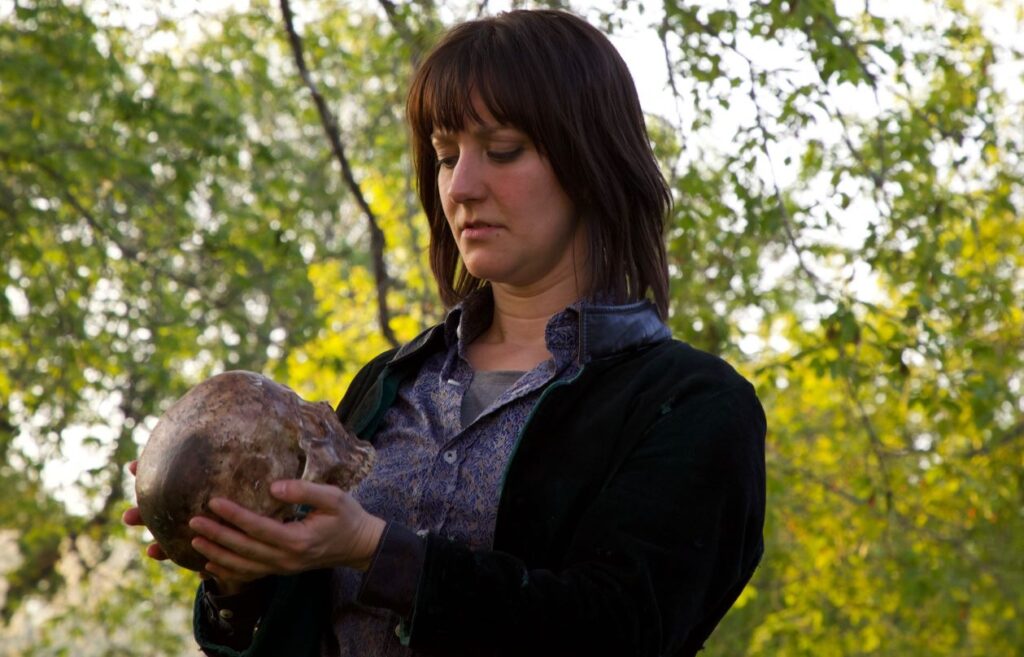Gender, Evolution, and Adaptation in Shakespeare’s Plays
By Lauren Chochinov
Heather Russell-Smith gender-occupies the role of Hamlet, 2019 (photo by Leif Norman)
During Shakespeare’s lifetime, women were famously not allowed to act on stage. This is not to say that women didn’t act at all – there are records of aristocratic women performing in private pantomimes, for example – but women could not be paid actors in public venues. Curiously, no law existed that outright banned women from public performance. Yet it was a rule socially enforced throughout the period. This is, perhaps, due to the homosocial environs of the theatre world during Shakespeare’s time. Plays were performed and written specifically for acting companies that essentially functioned like trade guilds – all male spaces that would not be suitable for women. The division between the public and private sphere is also crucial in understanding why women were not allowed to be professional actresses. Women were typically relegated to the private sphere of the home where they played specific roles that were not to crossover into public spaces.
As such, Shakespeare obviously wrote his plays knowing that young men would play the women’s parts. His plays are full of references to gender – the comedies especially lean heavily into tongue-in-cheek references to interiority and exteriority with their incorporation of disguise. In Twelfth Night, for example, the heroine Viola disguises herself as a man and proceeds to secretly fall in love with Duke Orsino, inadvertently creating a queer love triangle between her male persona, Cesario, the Duke, and Duchess Olivia. When Viola realizes that Olivia has fallen in love with Cesario, she exclaims “I am the man: if it be so, as ’tis,/Poor lady, she were better love a dream” (II.ii.25-26).[1] A male actor, playing a female character, who disguises herself as a man announcing, “I am the man” is a clear reflection of Shakespeare’s meta commentary on his actors and characters.
While this gender confusion provides comedic moments, it also illuminates Elizabethan concepts of masculinity and femininity beyond the exterior trappings of costume and makeup. Shakespeare’s characters often discuss the nature of the sexes. Renaissance theories of medicine believed in the four humours – body fluids that controlled mood and disposition. The balance, or more often, imbalance of the four bodily humours were used to explain ailments and temperament, as well as gendered stereotypes about men and women.
On August 9, 1588, Queen Elizabeth I stood before her army at Tilbury and in a rousing speech said, “I know I have the body of a weak and feeble woman; but I have the heart and stomach of a king.”[2] Early Modern medicine and scientific theory supported the idea that men and women were different in all aspects from their outward physical appearance to their temperament to the temperature of their bodies. When Lady Macbeth demands, “Take my milk for gall, you murdering ministers” (I.v.48),[3] she is asking that her natural feminine kindness be replaced with “gall,” yellow bile from the gallbladder that was associated with ambition and aggression. She is asking for not only a change in demeaner, but a change in the physical composition of her body that defies nature itself.
From 1642 – 1660, England’s Puritan government banned all theatre, shuttering stages across the country. With the restoration of the monarchy in 1660, theatres reopened under new guidelines enforced by King Charles II. In a 1662 patent, Charles ordered that ownership of the entire catalogue of existing English plays would be divided between two acting companies and, perhaps more intriguingly, that women were now to play women’s roles on stage.[4]
When the first woman actress appeared as Desdemona in a December 1660 production of Othello, her arrival marked a permanent change in the way Shakespeare’s play were performed.[5] All-male companies were no longer the norm and by the eighteenth century, actresses were playing male roles too, forging a new path of gender expression that continues to this day. While Shakespeare liked to point out that what was on the outside was not necessarily what was on the inside, his exploration of identity and sexuality enables an endless variety of interpretations and adaptations that shift and change with each new production of his works, offering audiences moments of celebration, humour, tragedy, and defiance.





